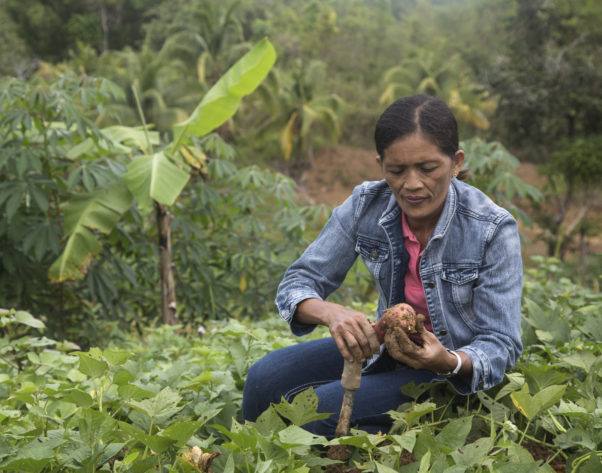 As developing countries cope with the effects of climate change and its impact on agriculture and rural livelihoods, a recently-concluded study from the International Potato Center (CIP) finds that root and tuber crops – such as cassava and sweetpotato – have a key role to play in helping smallholding farmers respond and adapt to changing environmental pressures.
As developing countries cope with the effects of climate change and its impact on agriculture and rural livelihoods, a recently-concluded study from the International Potato Center (CIP) finds that root and tuber crops – such as cassava and sweetpotato – have a key role to play in helping smallholding farmers respond and adapt to changing environmental pressures.
This conclusion and others are contained in a report authored by Gordon Prain and Diego Naziri, which was one of the key final outputs of the project Food Resilience Through Root and Tuber Crops in Upland and Coastal Communities of the Asia-Pacific, or FoodSTART+. The overall focus of the project, which was funded by the International Fund for Agricultural Development (IFAD) and the European Union, was to enhance food security and climate resilience among poor farming households in the environments most vulnerable to climate change within the Asia-Pacific region.
Building on an extensive review of the literature and on ground-truthing communities in the Philippines and northeastern India which are supported by IFAD, Prain, and Naziri took a multi-faceted and multi-method approach to their topic, documenting not only the particular biophysical characteristics that make roots and tubers (RTCs) valuable for contending with climate change, but also showing how they have been integrated as key components of ancient agri-food systems in the region, especially among ethnic minority shifting cultivators in hill areas and as food security crops in lowland flood plains and coastal zones. The characteristics of the crops can contribute to adaptive responses to shocks and stresses and strengthen what they call “agri-food system resilience”, a concept they elaborate based on a review of the literature on resilience.
However, knowledge of how root and tuber crops might be used strategically to prepare, cope with and recover from climate change shocks and stresses has not been thoroughly understood and documented. An improved understanding could help rural households achieve and maintain food and nutrition security, while also earning additional income through root and tuber sales.
The authors show how the adaptability and food system potential of potato, cassava, and sweetpotato have contributed to major transformations in agri-food systems in the Asia-Pacific region. These crops can also tolerate and/or resist physical stressors like heat, drought, salty soils, and water logging. Moreover, climate change effects can increase biotic stressors, like viruses, and recently released RTC varieties possess a superior tolerance or resistance level to many of these constraints. In post-disaster recovery times, these crops are valuable because they have short growing cycles, meaning families can produce more food in less time – a particularly valuable quality after floods, typhoons and other forms of disasters. Notably, breeders at CIP are presently striving to develop new high-yielding varieties that maintain and even enhance these naturally occurring characteristics, which are key amidst climate change.
Through focus group discussions with women and men farmers in the study sites, the authors then attempted to understand the various forms of preparation, coping and adaptive strategies local communities had deployed in responding to shocks and stresses that they had faced over the previous 10 years. While the study found that household assets are very important in facilitating different responses to crisis, they are not definitive. Individual, “subjective resilience” is also important, as are different types of social capital. Testimony from local farmers also confirmed findings of other studies that enhancing access to seed would be a key ingredient for supporting longer‐term recovery in all contexts.
As Prain noted “The field studies confirmed that following a calamity, farmers work hard to recover. They are determined to plant again the destroyed fields and they borrow seeds or get them in the market to make that happen. The short growing cycle of many roots and tubers makes them prime candidates for seed distribution to enable faster recovery. However, if done inappropriately, well-intended seed distribution can undermine local seed systems and businesses and has sometimes introduced new diseases causing problems worse than the ones meant to fix”. But access to seed alone would not be enough for improving agri-food system resilience with RTCs. Rather, as Prain and Naziri stress, innovative collaborations between the private and public sectors and increased investment in climate change adaptation initiatives will be necessary to unleash the potential of roots and tubers to address poor nutrition, gender inequality, and faltering incomes in the future.
A full copy of the report with an extensive literature review is available here.
This blog was first published on the CIP website.
